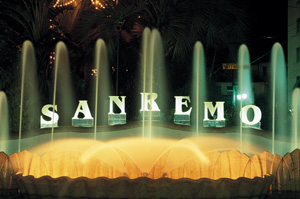|
Sanremo is a city with about 57,000 inhabitants on the Mediterranean coast of western Liguria in north-western Italy. It was founded in Roman times and is now best known as a tourist destination on the Italian Riviera and the host of cultural events such as the Sanremo Music Festival. It is widely accepted as the origin of the Five-card stud variant, Telesina.
Once the Roman settlement of Matutia or Villa Matutiana, Sanremo expanded in the Early Middle Ages when the population moved to the high grounds and built a castle and the walled village of La Pigna to protect the town from Saracen raids. At first subjected to the countship of Ventimiglia, it later passed under the dominion of the Genoese bishops, who in 1297 sold it to the Doria and De Mari families. It became a free town in the second half of the 15th century and spread on the Pigna hill and at Saint Siro's Basilica, the Cathedral. The almost perfectly preserved old village remains.
Sanremo remained independent from Genova (Genoa in English) for a long time, and in 1753, after 20 years of fierce conflicts, it rose against the hegemonical attempts of the Genoese city-state. At that time that the Genoveses built the fortress of Santa Tecla situated on the beach near the port. The fortress was used as a prison until 2002, and is now being transformed into a museum. After the French domination and the Savoy restoration (1814), Sanremo was annexed by the Kingdom of Sardinia.
| |
 |
The town grew bigger from the middle of the 18th century with the development of tourism: the first Grand Hotels were built and the town extended along the coast. Famous people such as the Empress Elisabeth of Austria "Sissi", Czar Nicola of Russia, Alfred Nobel, Italo Calvino and the Empress Maria Alexandrovna stayed here; of the latter we are reminded today when walking along the promenade of the same name along the sea and by the attractive Russian Orthodox church of San Basilio, erected in 1912 by the local Russian community.
Sanremo shows a climate that is often described as one of 'perpetual spring', with warm days and chilly nights and little variation of temperature around the year. Sanremo enjoys special weather conditions throughout the year due to its vicinity to the Mediterranean Sea and the presence of Maritime Alps right behind the town, Monte Bignone, the highest peak, being some 1,300m above sea level. These conditions make Sanremo one of the most attractive tourist destinations on the Italian Riviera. There are plenty of tourist attractions open year-round and it has numerous and well-equipped sports facilities, such as a golf course and a riding ground. There are two tourist harbours, Porto Vecchio and the modern Porto Sole. Many boutiques and local shops are in the town centre. The colourful market, held on Tuesday and Saturday mornings in Piazza Eroi Sanremesi, is famous among the people living in the Italian and French Rivieras.
The Municipal Casino and the Ariston Theatre offer annual series of concerts, operas and theater plays. The Symphony Orchestra is one of twelve symphony orchestras recognized by the state of Italy and it performs some 120 concerts throughout the year, most in the Municipal Casino's Opera Theater. The Ariston Theater hosts the annual Sanremo Music Festival, a very popular song contest held in the city since 1951. This festival inspired the Eurovision Song Contest, which started in 1956, and for years the Sanremo festival selected the Italian entry. The internationally famous song "Nel Blu Dipinto di Blu", also known as "Volare", was performed at this festival for the first time by Domenico Modugno in 1958. The festival is so popular amongst Italians that it is often referred to simply as "Il Festival" (The Festival). |

